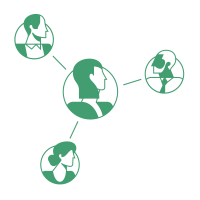
Just imagine: you don’t feel well and it affects your daily performance. You go to a care provider to cope with the situation. At home, you find it impossible to explain to your loved one how every day is a struggle. Wouldn’t it be nice to have a tool that can make your situation tangible for him or her?
Or the other way around: your mother suffers from panic attacks and you really want to help her when she’s not doing well. Some advice from her care provider would be a great help.
Relatives in the care pathway
The involvement of relatives in the care pathway results in a better understanding, a faster recovery, less anguish and fewer relapses. That is why it’s such a pity that relatives are not always involved in this process. Treatment is often seen as something that’s between the client and the therapist or care provider. Because of that threshold, a relative tends to feel like an outsider. Care providers are often in a similar situation: you have little grip on a client's surroundings, even though the surroundings have a very big impact on well-being.
 Still, there are not enough practicable methods to unite those two worlds. On behalf of the Gx (a collaboration of nine innovative mental health services), several organisations have taken the bull by the horns and asked Minddistrict to help them develop a solution.
Still, there are not enough practicable methods to unite those two worlds. On behalf of the Gx (a collaboration of nine innovative mental health services), several organisations have taken the bull by the horns and asked Minddistrict to help them develop a solution.
We developed the Social Support Network: an accessible functionality that enables the client's network to have a big role in the care pathway.
The role of digital interventions
Various studies (such as those conducted by Richards and Allam) show that digital platforms are a good way of involving relatives. Online tools can especially help to set up the triangle that consists of the client, the care provider and the network. Here are some of the options offered by the digital platforms that have been studied:
- Support outside of direct care: Chat and forum functionalities enable clients and their relatives to support each other. Care providers can also take part, but even without their intervention the client and his or her relative give each other support.
- A better insight for care providers: Communication platforms for both clients, their relatives and care providers offer professionals a better insight into the dynamics between the client and his surroundings.
- Direct communication: The client, care provider and relative can communicate directly, without one of them having to act as ‘intermediary’. This makes it easier to take decisions and make agreements.
- Acknowledgement and recognition: Presenting inspiring personal stories can offer support, solace and insight. It can also result in a better understanding from relatives.
It seems that digital communication can lower the contact threshold because you can always share things. Also, actively taking part in a discussion is not a requirement, you can come and go as you please.
What are your ideas about the role of relatives in care? What are your needs and wishes in that respect? These are the questions we posed to clients, care providers and relatives with ties to the health services Dimence, Siza, Reinier van Arkel, GGzE and Transfore. We also asked them how they envisaged this in terms of digital care.
Based on a large number of interviews, we identified the following benefits of the online involvement of relatives, in other words, social support:
- For the client, it is pleasant to receive support and understanding from his or her own network this way.
- The relative receives practical information about the client’s experiences and how he or she can help the patient. The social support network also offers relatives the possibility to receive support themselves.
- Having a more active role in the treatment is pleasant for both the client and his or her relative. It prevents a sense of isolation.
- The care provider has a better insight into the client’s surroundings, making it easier to adjust when necessary. The picture formed is more complete, also after treatment has ended and that, of course, helps to prevent relapses.
The keyword is grip. Everyone has a better grip on the situation and those involved actively take part in the care process. This has various positive consequences.
Who can benefit from this?
We’d like to introduce you to Bart.
Before we do, we’d like to draw your attention to the following: some parts of this case are still under development and are, therefore, not yet directly available.
Bart has been without a job for two years now because he suffers from depression. Martin, his husband, finds it increasingly difficult to deal with the situation. ‘He drags everyone into his darkness. He’s too busy with himself to really form a part of the family.’ Their daughter also suffers from the situation, as a result of which she's often involved in arguments at school.
 Martijn would like to understand what’s going on and what he can do to help. At the moment, he feels that everything he does has an adverse effect. It takes up so much of his energy, he’s starting to feel ‘burned up’. He feels as if he can no longer be there for the family.
Martijn would like to understand what’s going on and what he can do to help. At the moment, he feels that everything he does has an adverse effect. It takes up so much of his energy, he’s starting to feel ‘burned up’. He feels as if he can no longer be there for the family.
Bart feels like he’s constantly under attack. He wants Martin to understand how difficult it is for him and he doesn’t want Martin to be so angry all the time. 'I'm really trying.'
Social support in practice
Bart shares this feeling of a lack of understanding with Becca, his care provider. She thinks the social network is the perfect addition to his treatment: Bart is given the opportunity to share bits of his online treatment with Martijn. ‘See, this is how I feel.’
Martin himself will take online training: psycho education that focuses on depression. He is offered solutions to reduce his sense of powerlessness as well as tips to keep looking after himself.
It also creates an opportunity for Becca. She asks Bart if he can start a group discussion. That gives her the chance to get a better picture of the home situation and to respond to that. She can prepare treatment components in which Bart and Martin work together, such as designing a relapse plan. The warning signs that Martin sees differ from those seen by Bart and at times, Martin is quicker to spot them.
A few weeks later, Bart and his daughter visit a petting zoo for the first time in two years. Martin surprises him with a video message: he will cook an extensive dinner tonight.
Reasons to use social support
 The social support network demonstrates that digital tools can enrich the care pathway. A good care provider is irreplaceable but he or she could benefit from digital solutions, especially when it comes to involving a client's social network in the care process.
The social support network demonstrates that digital tools can enrich the care pathway. A good care provider is irreplaceable but he or she could benefit from digital solutions, especially when it comes to involving a client's social network in the care process.
In order to get the most out of the social support network, the care provider's working method will have to be modified. After all, you can only benefit fully from the possibilities offered by e-health (and in this case, the social support network) when you dare to change. That may sound difficult but we are convinced that making that first step shows that it's not impossible. Let's start tomorrow.
Want to find out when we start rolling out this new functionality? Just contact us!
